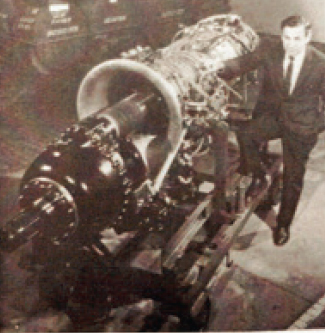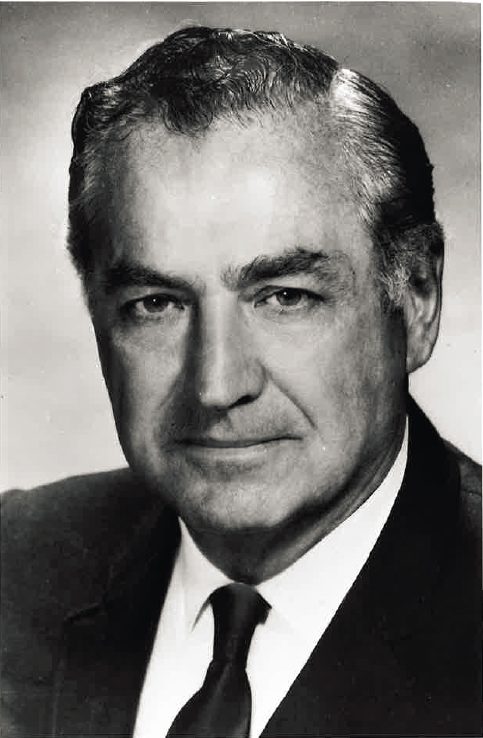

EDWARD WOLL
1914–2010
Elected in 1977
“Contributions to the pioneering development and evolution of aircraft gas turbines.”
BY FREDRIC F. EHRICH
EDWARD WOLL, a pioneer in the development of jet engines in the United States, died December 17, 2010. He was 96, with a mind that retained its keen edge. The day before his death he was “talking shop” with a colleague at his retirement home in Westwood, Massachusetts.
Eddie was born May 29, 1914, in Boston to parents who had immigrated from Minsk and Lvov; he had three brothers and a sister. He graduated from Boston Latin School in 1931 and got his BS degree in mechanical engineering from the Massachusetts Institute of Technology in 1935.
He started his eventful and productive career as an Army Air Force officer during World War II in the Power Plant Laboratory at Wright Patterson Air Force Base. He left Wright Patterson as an Army captain at the war’s end and continued his gas turbine work at Rensselaer Polytechnic Institute, where he received his master’s degree in aeronautical engineering in 1946.
Degree in hand, he joined General Electric Company’s nascent Aircraft Gas Turbine Department as a development engineer. First quartered at Boston’s North Station, the department moved to Lynn, where Eddie managed product planning, engineering, and engine development projects. After becoming manager of the Small Aircraft Engine Department
(1961–66), he rose to the positions of vice president and general manager of the Military Engine Division and the Engine Group’s Advanced Engineering Division. He retired as vice president of GE Aircraft Engines in 1979.
He distinguished himself early on with the design and development of the first successful US afterburning jet engine with variable area nozzle (J47-GE-17). He went on to lead the conception, design, and development of a series of turboshaft/turboprop engines:
- the T58, about which Kenneth M. Rosen (NAE 1997), former VP of research and engineering at Sikorsky Aircraft Co., UTC, noted that “Ed led the development of the T58 turboshaft engine and greatly contributed to its subsequent successful experimental installation in the nose of a Sikorsky S-58 helicopter. This event was a real technological turning point for both GE and Sikorsky. The aircraft first flew in 1957, and proved to be a great technical success…as did the free turbine concept pioneered by Ed.”
- the J85 turbojet engine family—which made possible the first modern “lightweight fighter” (the Northrop F-5 “Freedom Fighter”) and T38 trainer—and its derivatives;
- the CJ610 (commercial aircraft derivative);
- the CF700 (aft fan version), which powered thousands of aircraft, from military fighters and trainers to business jets (such as the CJ610-powered Learjet and the CF700powered Dassault Falcon), in over 30 countries; and
- the TF34 engine, which powered (i) the aircraft carrier–based S-3A (it entered Navy service in 1974); (ii) the A-10 Thunderbolt, known as the “Tank-buster”; and (iii), in its derivative commercial version (the CF34), the Bombardier Challenger commuter airliner, among others.
Ed was also a leader in conceiving, designing, developing, and applying two successive generations of advanced turboshaft/turboprop engines—embodied in the T64 and T700—that revolutionized helicopter propulsion in the 1950s and 1960s.
Each engine embodied a wave of new technology that enabled lighter weight, lower fuel consumption, fewer emissions, and less operating cost for users. Today they power more than 15 types of aircraft in both military applications (such as the T64/Sikorsky CH-53 heavy-lift helicopter and the T700/Sikorsky H-60 “Hawk” series of helicopters) used by the US Army, Air Force, Navy, and Marine Corps and commercial applications (such as the CT7/Sikorsky H-70 helicopter and CT7/Saab 340 turboprop commercial transport) used around the world.
Never one to rest on his laurels, he helped conceive and direct development of
- the low-bypass fighter engines (so-called cool-skin engines) that powerered a new lightweight fighter generation, the advanced development YJ101 engine, which powered the experimental fighter YF-17 and reached mass production as the F404 engine powering the F-18 series of fighter aircraft—this series is considered the leading powerplant in its class and is the benchmark for an entire generation of military combat aircraft propulsion systems for simplicity, design-to-cost, and ease of maintenance to balance the advanced technology features vital to its success;
- the F101X engine, which matured into the renowned F110 fighter engine that powers the world-class F-15 and F-14 aircraft; and
- the CF6 and CFM56 subsonic transport engines and the F101 supersonic bomber engine.
He was also a key player in the joint development program with France’s Société Nationale d’Étude et de Construction de Moteurs d’Aviation (SNECMA), a renowned model of international cooperation that developed the CFM56 turbofan engine that powers, among other aircraft, the Boeing 737 and the Airbus A320/A340 and is the most successful and numerous commercial transport engine ever produced.
Under Ed’s indefatigable and visionary leadership, GE was responsible for successful demonstration of the NASA-sponsored
Energy Efficient Engine (E3). The advanced-technology powerplant had a 13.5 percent lower specific fuel consumption rate than the base CF6-50 engine. Substantially lower emission targets were also achieved. The engine was later used as the technology base for the GE90 engine that powered the Boeing 777 modern large commercial aircraft.
A leader for the entire spectrum of GE aircraft engines, Eddie was recognized as the driving force behind the GE engine business’s Zero Defects program, for being on a first-name basis with employees as he walked the shop floor, and for cultivating and mentoring young engineers. In appreciation of these attributes, the division’s auditorium at Lynn was named in his honor on his retirement and he was elected to the GE Propulsion Hall of Fame.
For his considerable contributions he received many honors, including the American Institute of Aeronautics and Astronautics’ Air Breathing Propulsion Award (1977), “for 30 years of sustained significant contributions to the aircraft industry through innovative conception, design, and development of gas turbine engines, including the total engine spectrum from small turboshaft to large bypass turbofans; through active participation in many technical societies and advisory boards; and through innovative leadership in design-to-cost principles”; and, from the Vertical Flight Society, the Dr. Alexander Klemin Award (1975), “For his years of leadership in design and development of jet engines, and his prime influence in overall design of the US Army T700 turbo-shaft engine to power advanced helicopter of the 80s.”
In addition to his NAE membership, he was a distinguished member of the Jet Pioneers Association of America and a fellow of the AIAA. Over the years, he served on many national, industry, and professional committees dealing with standards, regulation, sponsorship, and specification of gas turbine aircraft engine technology. And for his alma mater he was secretary of his class and established an endowed education fund for MIT undergraduates.
Eddie Woll was a major force in the gas turbine industry and a leading contributor to aircraft engine science and
technology—and a rare species in an industry with a lot of macho, tough guys. He was gentle-mannered, gentlemanly, considerate, and very careful and thoughtful in his dealings with people.
He resided most of his adult life in Wenham, MA, where in about 1947 he bought a house that was built in the mid-1600s (when they moved in it had no plumbing). He and his wife, Barbara (who predeceased him), restored that precious antique of a home over many years.
Eddie is survived by his daughter, Barbara Jones (Falmouth, MA), and son, Edward Woll Jr. (Cambridge, MA), six grandchildren, and five great-grandchildren.






